Lab Grown Diamonds 101: Discovering the Science, Certification, and Market Trends

At GCAL, we certify loose diamonds, gemstones, and finished jewelry… backed by our guarantee, ISO accreditation, RJC Certification, and SCS accreditation… offering diamond measurements and testing, Gemprint, grading, light performance, photomicrographs, 360 video and laser inscription.
We offer a variety of different products from natural to lab grown, print to digital, full certs, mini certs, cards and tags.

In the exciting news department, Sarine just finalized their acquisition of a majority stake of GCAL in May 2023, instantly taking GCAL from a US based laboratory only, to having a global foot print, backed by Sarine’s infrastructure, and most importantly, access to Sarine’s AI Based Color and Clarity grading systems, along with a verifiable traceability solution, Sarine Diamond Journey.
Lab Grown Diamonds vs. Imitations

The term ‘DIAMOND’ without any other qualifiers, should only be used to refer to diamonds naturally formed in the Earth.
When referring to lab gown diamonds you can use the terms Lab Created, Man-made or Synthetic or a manufacturer’s name, such as Chatham-Created, immediately proceeding or following diamond.
Imitation Diamonds or simulants are materials such as CZ and Moissanite that look similar to diamond but have different chemical, physical and optical properties. Make sure these are clearly labeled and never represented as a lab-grown diamond.
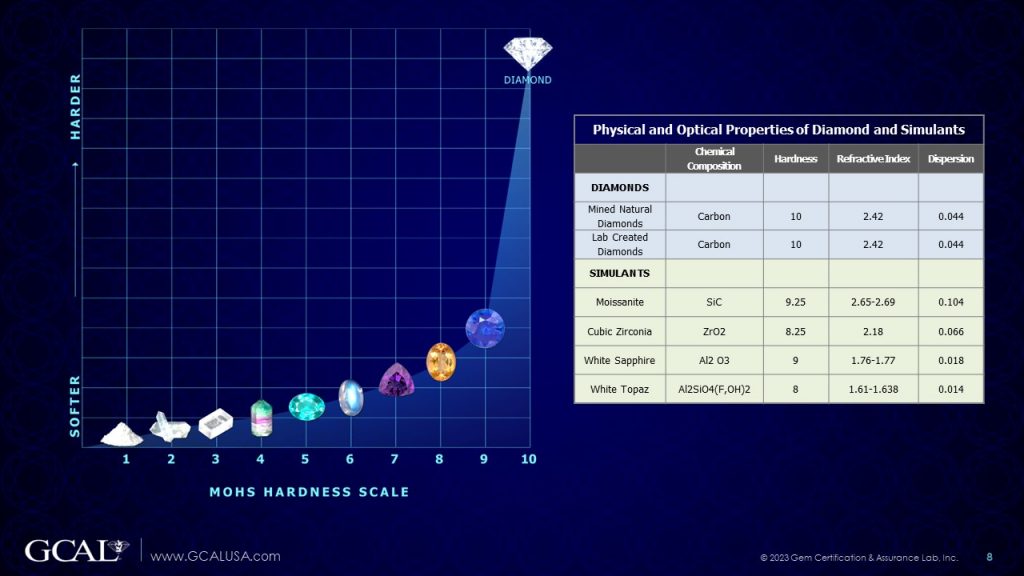
There is truth to the saying Diamonds are Forever. Diamonds are 10 on the Mohs hardness scale which makes them the optimal choice for engagement rings that are worn everyday for decades. Any other gemstone or diamond simulant would become scratched and dull after only a few years of daily wear.
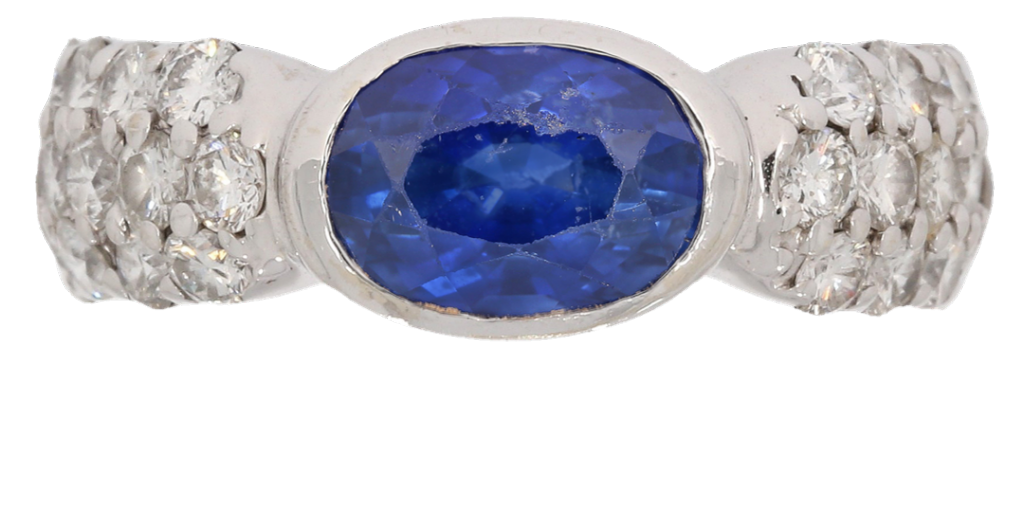
Sapphire is 9 on the Mohs hardness scale, but worn every day, will show signs of wear, abrasions, and scratches.

This photo shows the range of beautiful colors lab grown diamonds are available in. So if you are selling diamonds and lab grown diamonds – be excited about it – what an exceptional product you get to share with your customers that has the durability to be worn and enjoyed everyday.

Over 100 years ago, scientists were racing to be the first to grow diamonds. It took more than 50 years of experimentation for a true diamond crystal to be created in 1953. Fast forward another 50 years and several companies have the technology to grow GEM quality lab grown diamonds. But it is really the past two decades that gem quality synthetic diamond production has matured and become a new segment of our industry.

20 years ago in 2003, this was the cover of WIRED magazine. It was interesting news at the time but wasn’t reality, yet. At that time, only limited quantities of melee and fancy colors were actually being produced. Let’s fast forward another 12 years to when gem quality, near colorless really started becoming commercially available.
Heat Maps

This heat map illustrates the distribution of colors and clarities of commercially available lab gown diamonds in 2015. Look at the orange and red areas – these were the most commonly occurring grades. In 2015 you can see that J-K/SI2 and I1 were the most common.
The following heat maps show how the qualities have improved in the following years.

In 2016, the most common qualities were H-J, VS1 and below

In 2017, minor changes were made – I still the dominant color, and clarity started to slowly improve to more VS quality.
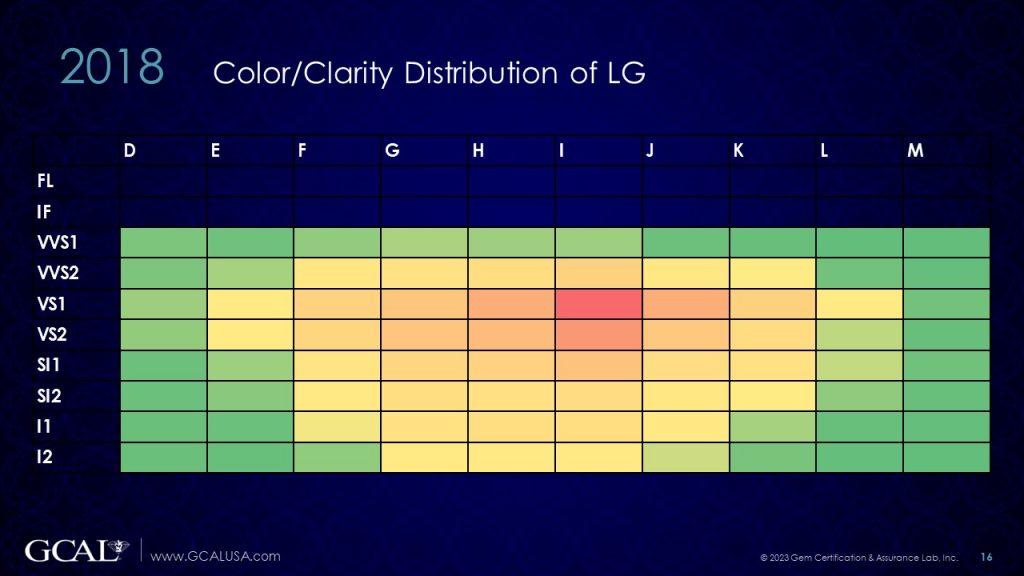
In 2018, the heat map is nearly identical

Mid 2018 saw the announcement of DeBeer’s entry into the Lab Grown Industry – this greenlit all sight holders and major manufacturers to publicly enter the lab grown space. Manufacturing expertise plus significant capital enter the market, and we saw the first big shift in overall quality in the market over the course of 2019.

There is a continuation of the improvement of quality – huge shift in color, where E-G became the most common range of color.

In 2021, the big change we saw was IF clarity and more D colors.

2022 saw improved color and improved clarity with a range now of D-G/VS1-VS2. And so far 2023 has shown continued improvement.
Growth Methods
There are two methods of growing diamonds:
- HPHT method – High Pressure High Temperature
- CVD method – Chemical Vapor Deposition
We are going to discuss each, and the characteristics of diamonds grown by each methods. It is important for you to become familiar with the characteristics of each type so you can answer customers questions and because it influences how you identify and detect them.
First you need to know the two methods for producing synthetic diamonds. The identification characteristics of each type are different.
HPHT Grown Synthetic Diamonds

There is the High Pressures, High Temperature (HPHT) method that produces cubo-octahedral crystals. These are grown in a molten metal and therefore commonly have metallic flux inclusion – dark crystals. Much of the melee, under 0.03 ct, in the market has been grown by the HPHT method. Initial investment and energy costs of HPHT are higher than the CVD method.
CVD Grown Synthetic Diamonds

The CVD method uses a carbon plasma cloud to grown diamonds on seed plates. This method produces wafer shaped crystals that are usually brown to near colorless. Post growth treatment can further light the colors. Because CVDs grow in layers we see characteristics such as planar clouds and inclusion in growth planes. Many CVD diamonds undergo several steps of growth. It can be more cost efficient to grow large high clarity diamonds with the CVD method. It is quite common to find jewelry manufactured with CVD center and HPHT melee.

The environment in which a diamond grows is often directly reflected in the inclusions we observe under magnification. These photos were taken by the Diamond View instrument and show the surface fluorescence which reveals evidence of their growth method.
All diamonds, including those grown naturally deep within the Earth and those grown in hi-tech machines, have the same chemical, physical, and optical properties. There are all made of carbon with atoms strongly-bonded in an isometric crystal structure. To the human eye, even a trained eye – they are identical. However, when illuminated with strong short-wave ultraviolet light, under high power magnification, experts can discern slight differences in their growth patterns. Very similar to the way grown rings of a tree can tell a tree’s history, the growth patterns of a diamond can identify its origin.
CVD Inclusions
Inclusions in CVD Grown Diamonds include:
- Clouds
- Crystals
- Pinpoints
- Feathers
- Graining
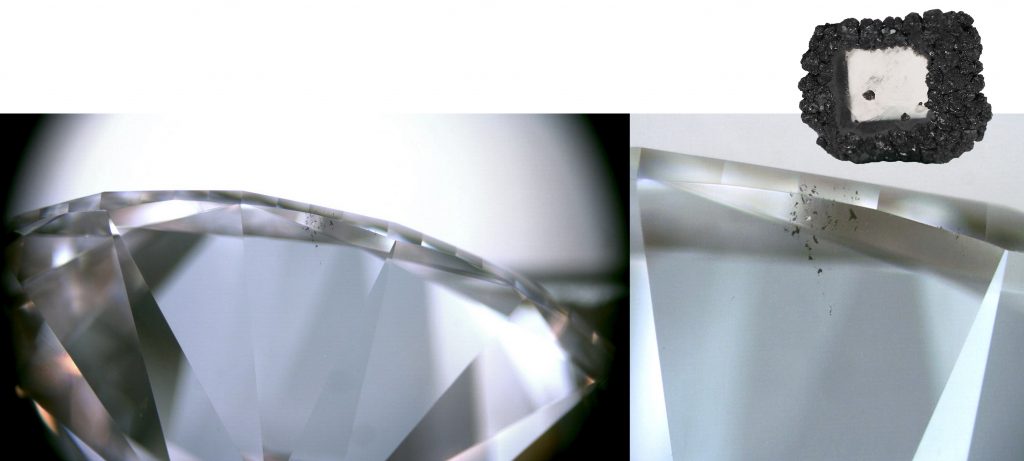
Very often the clouds in CVD are remnants of the polycrystalline diamond that grows on the edges of the CVD wafers as seen in these photos.
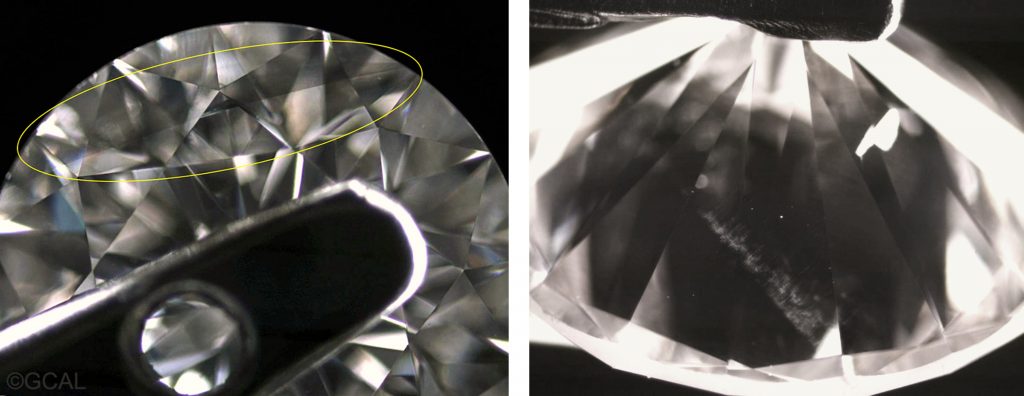
Due to CVD’s layered growth, clouds are often oriented along growth planes.
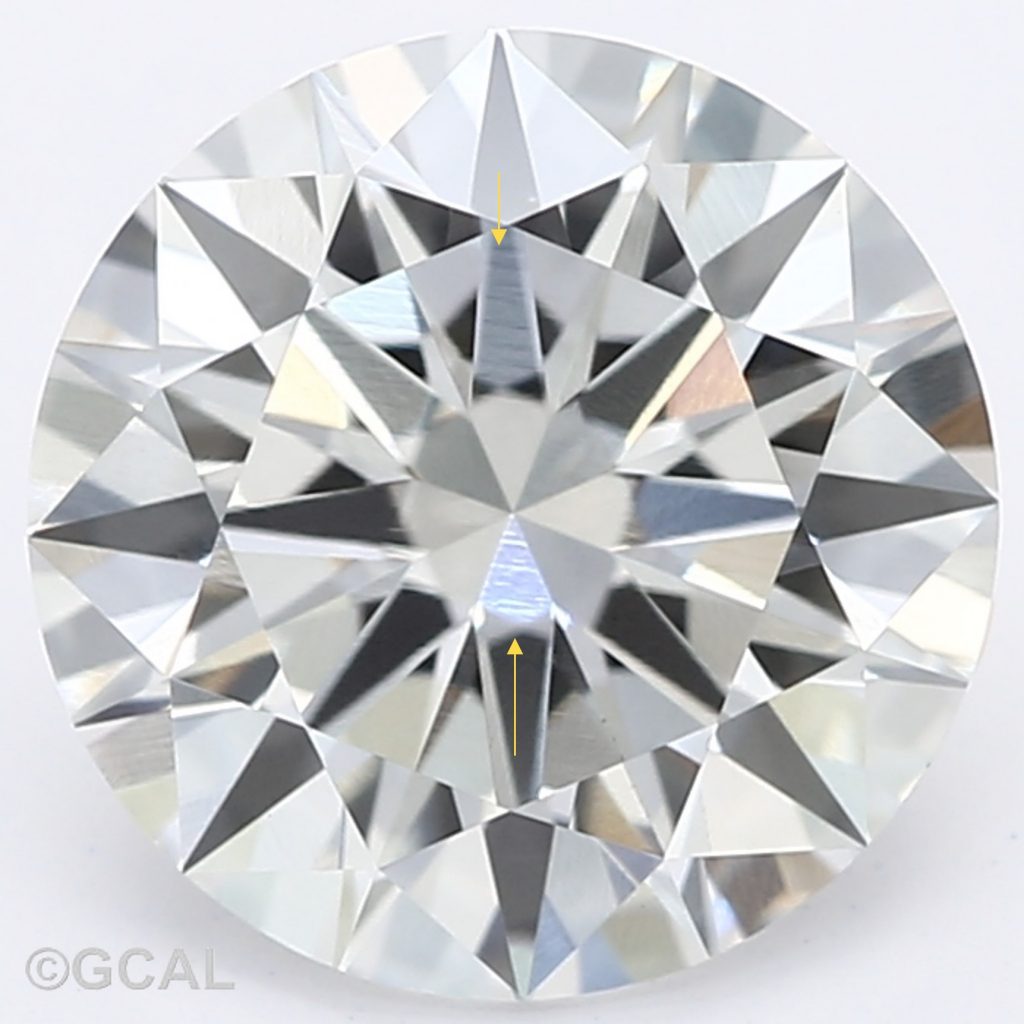
Some CVD’s can exhibit a grainy appearance. This is usually only seen at 10X or in magnified 360 videos, like these. In most of today’s CVD production, these are the exception to the norm, but online consumers are aware of this, and you should be too.

You should also be aware of the variations of hues, or tints, seen in CVD diamonds. These can be more brownish, grayish or orangy pink than the usual yellowish seen in natural diamonds. But colors have significantly improved in the last couple of years and can look very similar to natural colors.
HPHT Inclusions
Inclusions in HPHT Grown Diamonds include:
- Dark Metallic Flux
- Crystals
- Clouds
- Needles
- Cavities
- Pinpoints

Dark metallic flux is often seen as elongated or ‘pill-shaped’, opaque metallic inclusions which are a remnant of their origin in molten metal flux.

On a fun note, if the metallic inclusions are large enough, they will be attracted to a strong magnet.

Occasionally, we also see ‘hair-like’ needles or metallic platelets in HPHT grown diamonds.

HPHT grown diamonds are usually high color grades and Blue tints are common. The blue hue is due to boron impurities in the crystal structure. Other tints we see are yellow and green which can be described as bright and high in tone. Discerning ‘E’ or ‘F’ blue tints can be difficult in the mounting and appear more like ‘D’ colors to an unexperienced eye.
Here are two videos of G color stones:
HPHT (blue body color) – cooler color
https://www.gcalusa.com/certificate-search.html?certificate_id=313480230
CVD (brown body color) – warmer color
https://www.gcalusa.com/certificate-search.html?certificate_id=312390149

Another feather of HPHT grown diamonds that you should be aware of, is that a small percentage will fluoresce and phosphoresce during and after exposure to longwave ultraviolet light.
When we grade the Fluorescence of a diamond, longwave UV light of 365nm is standard in our industry. Under this type of light, around 5% of HPHT grown diamonds will fluoresce orange and will continue glowing for a few seconds up to a minute afterwards – this glow after the light is turned off is called phosphorescence. Your customer might see this reaction if they are in a blacklight or for example, if they go from the bright sun into a darkened movie theater. You can reassure them that this is ok and not a permanent change. Orange and red fluorescence also occasionally occurs in natural diamonds. The famous Hope Diamond fluoresces Red.

Some gemological UV lamps also have a Shortwave light. We do not use shortwave to grade the fluorescence of diamonds, but shortwave UV is used for gem ID and is the main type of light source used in screening and detection instruments, which will be covered more in-depth further down. But what I want you to know is that these are the same three diamonds as the previous image. The strength and color of the phosphorescence is determined by the wavelength of the ultraviolet excitation. Nearly 100% of HPHT grown colorless diamonds will phosphoresce this teal color after exposure to shortwave ultraviolet light.
Client FAQs

So to review, depending on the sophistication of your client, you may be presented with questions about characteristics of CVD and HPHT grown stones. For HPHT, the concerns are typically centered around blue tints and/or phosphorescence. For CVD, the concerns typically are brown tints, graining, and/or post-growth treatments. Since these concerns are exclusive to each growth method, and there is a prevalence of inventory in each category, you should be aware of these concerns, and be able to offer a stone that meets your customers requirements. For examples, if they are concerned about post-growth treatment, offer a HPHT. If they are concerned about phosphorescence, offer a CVD.
Identification

As a jeweler, your ability to identify all product that comes through your store, has never been more important. Jewelry is now being manufactured in huge quantities with natural diamonds, lab grown diamonds, moissanite, and other simulants. You need to be able to confidently identify all types, and we are going to give you an overview of the instruments available in the marketplace, to ensure you are equipped and ready for the challenge.
When selecting an instrument, you want to think about what you need it to do. Unfortunately, there is only one black box that can identify every diamond.
Are you buying over the counter and need 100% confidence that the stone is an natural diamond? Are you screening jewelry from a new vendor to make sure every melee is natural? Are you an appraiser and need to identify a wide range of items?
Diamond Testers

Before proceeding, it is essential to ensure that you have an actual diamond and not a simulant like CZ or Moissanite.
Traditional diamond testers are the kind that have a probe tip that you place on the diamond table and it beeps to indicate it’s a diamond or a simulant. The first generation of these testers was developed to distinguish between CZ (cubic zirconia) and diamond based on thermal conductivity. However, the introduction of Moissanite posed a challenge as it could ‘fool’ these testers.
Consequently, a second generation of testers was developed based on electrical conductivity – these are so called Moissanite testers.
There are also duel testers that use both methods.
Using these testers on LGD (Lab-Grown Diamonds) has caused many people selling LGD to face significant difficulties because some LGD can produce a Moissanite-like result. Boron doped HPHT grown diamonds and some CVD grown diamonds are electrically conductive. These LG diamonds produce a ‘MOISSANITE’ result. Some new Colorless Moissanite have very low levels of electrical conductivity. These Moissanite stones produce a ‘DIAMOND’ result.
Basically you need to understand their limitations. If you are selling LGDs, don’t pull one of these out to prove that are are selling them a ‘real diamond’. And if you are selling a LGD and your customer takes it somewhere else where they test it and tell them it got a Moissanite result, then you should be prepared with an answer. Show them the lab certificate, show them the laser inscription, educate them about the limitations of ‘diamond testers’.
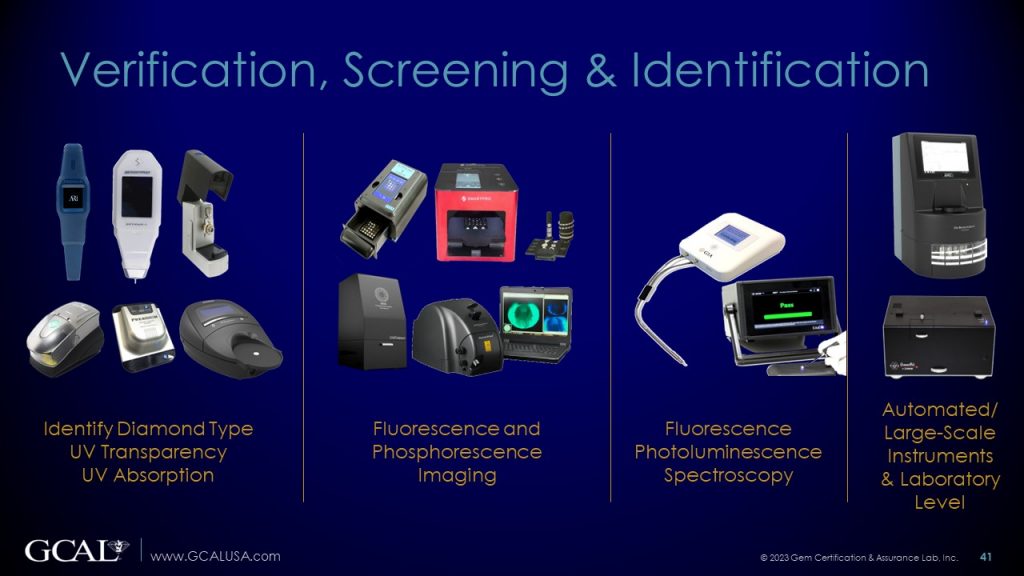
But there are a lot of options available, and it can be a bit overwhelming to select the right instruments. So here you can see we broke the instruments into groups by their testing methodology – what are they actually testing. This is important for several reasons, but especially if you are going to buy more than one instrument, you want to make sure you are diversifying your identification capabilities by purchasing instruments that test for different characteristics and utilize different methodologies.
We are going to discuss the first 3 groups here, which contain instruments you may want to have in your store. The last group comprises of automated equipment for large scale manufacturers, and laboratory level instruments, which we are not going to cover today.

Many screening devices on the market work on the principal of separating diamonds into the categories of Type I and Type II. Approximately 95% of natural diamonds are Type I – which means they contain nitrogen. Almost all colorless LGDs are Type II – which means the are void of nitrogen.
Most of these instruments are using the UV transparency method that measures whether specific bands of light can pass through a diamond. Natural type Ia diamonds are opaque to this light – they absorb or block shortwave, while Type II diamonds are transparent to this light – they transmit the light at specific short uv wavelength.

These are good instruments, at affordable entry points and are great for loose diamonds, although some can test mounted I do not think the results are as reliable. You should understand what the results mean – a ‘refer’ result or Type IIa result doesn’t mean it is a lab grown diamond. It just means that it needs additional testing and didn’t ‘pass’ as a natural type Ia. Each machine has different limitations and very specific operation instructions, you must adhere to, or you will get the wrong results. This is especially true for some instruments where they will pass a CZ as a diamond. You must read the instructions!

The next category is fluorescence and phosphorescence imaging instruments. These machines are built generally to screen natural diamond jewelry to spot or flag Lab Grown melee diamonds that might be mixed in. They can be faster for large quantities and are very effective for spotting HPHT grown melee. There is a wide range of prices and wide rage of interpretation and effectiveness, especially when it comes to flagging certain types of CVD grown diamonds.
Another thing you should be aware of when using this type of instrument is that every diamond must be exposed to the light and camera. Which mean you may have to put the same ring in three times at different angles to make sure you are properly testing every diamond. If it is in the foam holder, it will be missed.

The last category is spectrometers that are checking for the presence of N3 or cape absorption series found in natural diamonds. These instruments are very accurate – they have an extremely low false positive rate. Basically, if you get a ‘pass’ result, then you can be confident that you have a natural diamond. These will refer simulants such as CZ and Moissanite and they will refer all lab grown diamonds. If I were buying over the counter or appraising, I would definitely have one of these.

The Natural Diamond Council has undertaken a great project with their Assure Program. They are independently testing verification instruments using controlled challenging samples sets and publishing their assessment results. This is a great resource for you as you contemplate the right instrument for your store. There is a ton of information on their site and you should check it out if you are looking for any instruments.
Things to Consider When Selecting the Right Instrument:
- Type of diamonds you handle (loose/mounted)
- Volume of diamonds that you handle
- User interpretation / skill level / automation
- Type of results
- Portability
- Budget
In summary, when selecting an instrument think about what you need it to do, who will be using it, what type of volume you will be handling and do your homework. Then make sure to read the instructions, and practice with known samples.
Here is a list of distributors and manufacturers of Verification, Screening & Identification instruments we are aware of in the US:
The next bit of information is for any gemologists out there. It could be an entire presentation on its own, but I just want to introduce you to what can be done when equipped with standard gemological instruments and knowledge.

For example, if you know you have a lab grown diamond, but do not know if it is CVD or HPHT, using a set of pole filters on your microscope is a very simple and effective way to distinguish them. HPHT diamonds typically have no birefringence pattern, while most CVD diamonds have distinct cross-hatched or tatami pattern.

This shows a pendant we had made for teaching purposes. It contains 4 lab grown diamonds, 1 natural diamond, and 3 simulants.
What is important to note here is the usefulness of checking jewelry under UV light. It’s inexpensive and every jeweler and appraiser should have a UV light to check jewelry.

Never rely on one test, and when in doubt, send it to a lab for further testing.
Lab Grown Diamond Certification



In the LGD Market, you will primarily encounter grading certificates and reports from 3 companies… GCAL, GIA, and IGI. The most important commonality amongst the 3 is that we all grade LGD’s the same way as natural. Specific color, clarity, etc.
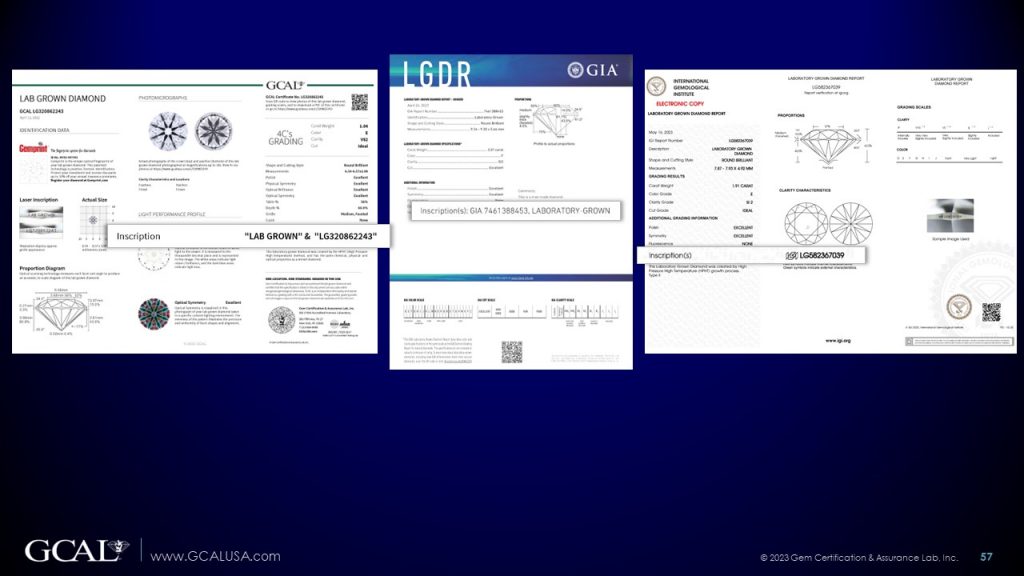
A standard feature is inscription, which is very important for disclosure. While we all inscribe something a little different, you will find some reference to LG, LAB GROWN, or LABORATORY GROWN on each of them.

You will also find varying references to growth method, diamond type, and in some cases, treatment.

You will also see some type of reference to grade setting inclusions/locations. At GCAL, we list the grade setting inclusions/locations by order of significance and also capture high resolution photographs so you can actually see the inclusion. The new GIA reports do not plot, and do not list inclusions or location and it appears that IGI plots, but does not provide any detail in key to symbols.
Shape Distribution, Over 1 Carat (2020-2022)

Let’s shift to trends now… One of the most significant trends we have seen is the rise of fancy shapes. 2020 was the first year on record where Rounds accounted for a minority of the submissions. In fact, since 2020, Rounds account for only 45% of the submissions, above 1 carat.

Lab grown diamonds range in clarity from IF to I3, but you can see the sweet spot (over the last 3 years) is VS1-VS2 for both HPHT and CVD. This directly reflects what producers can make in large quantities and consumer demand trends.

Lab grown diamonds come in every color, but you can see the range submitted to the lab generally falls in the D-L range, with E-G being most common in CVD and D-E being the most common in HPHT.

Another trend is the rise of online shopping and research. Consumers are more educated, doing more research, and in many cases, have as much knowledge as the sales associates selling them diamonds.

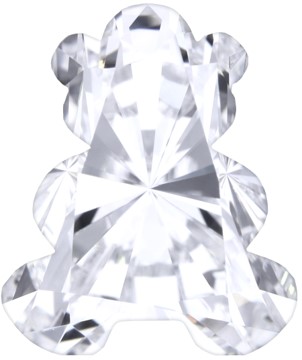
With the rise in popularity of lab grown, and the relatively less expensive cost of the rough material, we are starting to see a rise in custom, unique shapes. Here you see a CVD crystal, cut into the shape of Texas and one of a Teddy Bear.
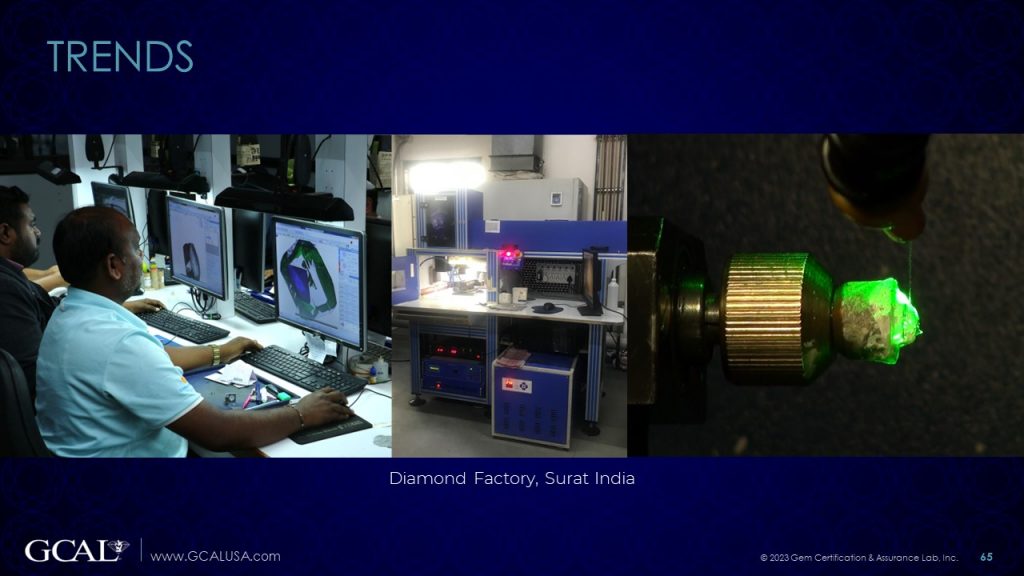
Another trend is the technological advancement across diamond factories, on a global scale. The equipment, technology, scalability, and craftsmanship displayed by the premier diamond cutting firms is remarkable. It has led to vast improvements in cut quality over the years.
Why Cut Matters…
Another trend we are seeing is the attention to detail that SOME manufacturers are paying to cut now. Cut is the most controllable of the 4C’s… it is what transforms a lifeless rough crystal into the brilliant polished diamond we all cherish… it is what unlocks the beauty of a diamond, and it is what sets premium manufacturers and retailers apart from their competitors. It is also how some LG manufacturers are setting themselves apart from the competition.

GCAL has been issuing cut grades on all shapes for the last 15 years… and every shape is assessed against proportions, finish, and light performance. Until April 2021, our cut grade went from Poor to Ideal. And in April 2021, we launched the 8X Cut Grade from Round Brilliance, which represents the top end of Ideal, or Super Ideal. In June 2022, we launched 8X for Oval and Princess.
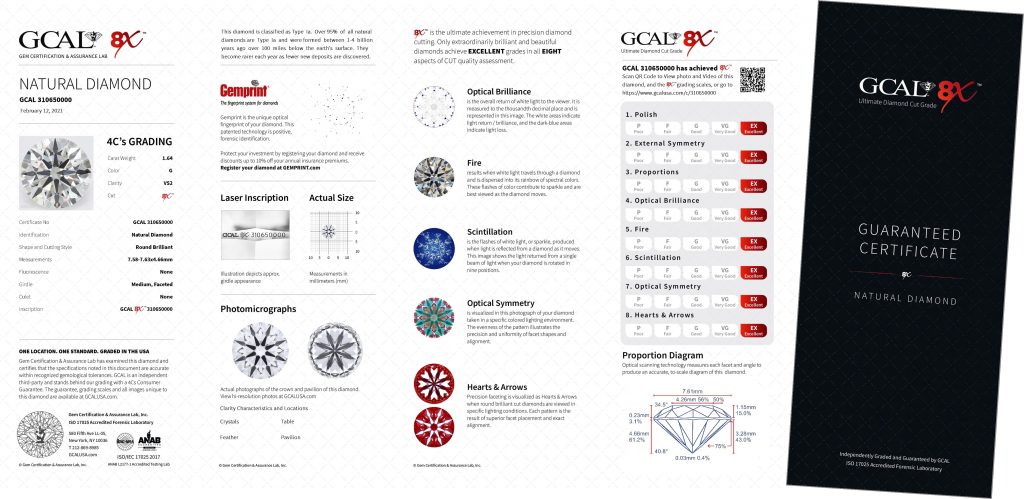
Premium Cut | Accurately Graded | Supported by Science | Guaranteed by GCAL

In February of 2023, we launched 8X for Proprietary and Patented Shapes. If our mission with 8X is to identify and distinguish the highest performing stones, then proprietary/precision shapes must also be included in the standard. We will be working with manufacturers to set and define standards and tolerances for each unique shape.

As mentioned earlier, Sarine’s acquisition of a majority stake of GCAL was completed in May, and we are now GCAL by Sarine.
I think many of you are familiar with Sarine products, and we could not be more thrilled to be partnered with them, ensuring that GCAL will be at the cutting edge of technological innovation for the years to come, and ensuring that our customers have access to the innovative products our combined companies will be bringing to the market.

And here are videos captured in the GCAL Lab of the Sarine Clarity machine at work. Analyzing, observing, and photographing the diamond in all the positions we as human graders would assess the stone by.
Presenters
Laura Moore: Managing Director of Jewellery Industry Network
Angelo Palmieri: President of GCAL by Sarine
Sharrie Woodring: Senior Gemologist at GCAL by Sarine
Noy Elram: Managing Director of APAC Sarine
Special thanks to Craig and Lonn Miller from JC Jewels for supporting this webinar.




